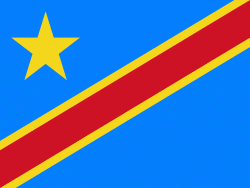Tshuapa District (Tshuapa)
Tshuapa District (District de la Tshuapa, District Tshuapa), was a district of the Belgian Congo and the Democratic Republic of the Congo created in 1933 in the Coquilhatville Province. At its greatest extent it roughly corresponded to the present provinces of Équateur and Tshuapa.
The original four provinces of the Belgian Congo had considerable autonomy, but in 1933 they were reorganized into six provinces, named after their capitals, and the central government assumed more control. The former Équateur Province was renamed Coquilhatville Province after the capital city of Coquilhatville. A map of the 1933 administrative divisions shows Bangala District and Ubangi District had been merged to form Congo-Ubangi District in the north. In the south, the districts of Lulonga and Équateur had been combined to form Tshuapa District.
Tshuapa District bordered the French possessions across the Congo River to the west, Congo-Ubangi District to the north, Stanleyville District to the east, and Sankuru, Kasai and Lac Léopold II districts to the south. The district was named after the Tshuapa River, which flowed westward through it to the Congo River.
Coquilhatville Province was renamed Équateur Province in 1947. By 1954 it had again been divided into Equateur, a smaller Tshuapa, Mongala and Ubangi districts. A 1955-1957 map shows Tshuapa District bounded by Mongala District to the north, Stanleyville District to the east, Sankuru, Kasai and Lac Léopold II districts to the south and Équateur District to the west. It covered the same territory as the modern province of Tshuapa. The area was 133000 km2 out of a total of 402100 km2 for Equateur province as a whole.
On 14 August 1962 the new provinces of Cuvette Centrale (Equateur and Tshuapa) and Ubangi were split off from Équateur Province, and the remainder of the province was placed under central administration, to become the province of Moyen-Congo (Mongala) on 5 February 1963. On 25 April 1966 Cuvette Centrale, Moyen-Congo, and Ubangi were reunited in a new Équateur province. On 11 July 2015 Équateur was split into a smaller Équateur province and the new provinces of Tshuapa, Mongala, Nord-Ubangi and Sud-Ubangi. Tshuapa Province was formed from the Tshuapa district, whose town of Boende was elevated to capital city of the new province.
The original four provinces of the Belgian Congo had considerable autonomy, but in 1933 they were reorganized into six provinces, named after their capitals, and the central government assumed more control. The former Équateur Province was renamed Coquilhatville Province after the capital city of Coquilhatville. A map of the 1933 administrative divisions shows Bangala District and Ubangi District had been merged to form Congo-Ubangi District in the north. In the south, the districts of Lulonga and Équateur had been combined to form Tshuapa District.
Tshuapa District bordered the French possessions across the Congo River to the west, Congo-Ubangi District to the north, Stanleyville District to the east, and Sankuru, Kasai and Lac Léopold II districts to the south. The district was named after the Tshuapa River, which flowed westward through it to the Congo River.
Coquilhatville Province was renamed Équateur Province in 1947. By 1954 it had again been divided into Equateur, a smaller Tshuapa, Mongala and Ubangi districts. A 1955-1957 map shows Tshuapa District bounded by Mongala District to the north, Stanleyville District to the east, Sankuru, Kasai and Lac Léopold II districts to the south and Équateur District to the west. It covered the same territory as the modern province of Tshuapa. The area was 133000 km2 out of a total of 402100 km2 for Equateur province as a whole.
On 14 August 1962 the new provinces of Cuvette Centrale (Equateur and Tshuapa) and Ubangi were split off from Équateur Province, and the remainder of the province was placed under central administration, to become the province of Moyen-Congo (Mongala) on 5 February 1963. On 25 April 1966 Cuvette Centrale, Moyen-Congo, and Ubangi were reunited in a new Équateur province. On 11 July 2015 Équateur was split into a smaller Équateur province and the new provinces of Tshuapa, Mongala, Nord-Ubangi and Sud-Ubangi. Tshuapa Province was formed from the Tshuapa district, whose town of Boende was elevated to capital city of the new province.
Map - Tshuapa District (Tshuapa)
Map
Country - Democratic_Republic_of_the_Congo
 |
 |
| Flag of the Democratic Republic of the Congo | |
Centered on the Congo Basin, the territory of the DRC was first inhabited by Central African foragers around 90,000 years ago and was reached by the Bantu expansion about 3,000 years ago. In the west, the Kingdom of Kongo ruled around the mouth of the Congo River from the 14th to 19th centuries. In the northeast, center and east, the kingdoms of Azande, Luba, and Lunda ruled from the 16th and 17th centuries to the 19th century. King Leopold II of Belgium formally acquired rights to the Congo territory in 1885 and declared the land his private property, naming it the Congo Free State. From 1885 to 1908, his colonial military forced the local population to produce rubber and committed widespread atrocities. In 1908, Leopold ceded the territory, which thus became a Belgian colony.
Currency / Language
| ISO | Currency | Symbol | Significant figures |
|---|---|---|---|
| CDF | Congolese franc | Fr | 2 |
| ISO | Language |
|---|---|
| FR | French language |
| KG | Kongo language |
| LN | Lingala language |















